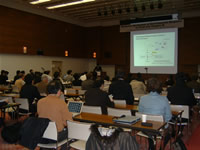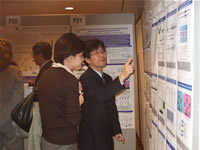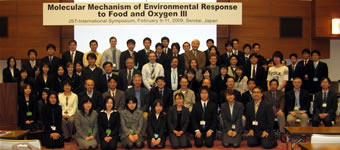The Molecular Mechanism of Environmental Response to Food and Oxygen III, co-hosted by JST and the Tohoku University School of Medicine, was held at the Gonryo Kaikan of the Tohoku University School of Medicine for the three days of February 9 to February 11, 2009.
The ERATO Yamamoto Environmental Response Project, as a JST Basic Research Program (November 2002 through to March 2008), hosted international symposiums on the theme of "Food and Oxygen" in 2005 and 2007, which were highly praised both locally and internationally. This third symposium aims to disseminate a well-rounded set of results of research achieved in the project world-wide as well as a comprehensive understanding of the molecular mechanism involved in environmental responses.
13 domestic researchers in total, mainly ex-members of the ERATO Yamamoto Environmental Response Project, and 9 world renowned active overseas researchers in the same research field as that of the domestic researchers, all made oral presentations at the symposium. About 40 poster presentations were also made by mainly younger researchers.
At the oral presentation session the most recent results of research on the theme of the molecular mechanism in environmental responses, centering on the Keap1-Nrf2 system that was clarified by the Yamamoto Environmental Response Project as the world leader in the subject, were introduced, followed by a lively exchange of views. Quite a few researchers who made presentations had newly entered the research field of environmental response during recent years, suggesting that the researcher population in the field of environmental response is rapidly increasing at the global level. Furthermore, the researchers come from a diverse range of backgrounds that include toxicology, chemistry, molecular biology, structure, biology and genetics, and the wide variety of backgrounds is a clear indication of growing cross-disciplinary interest in the field of environmental response. The poster sessions, held in the evening of February 9 and 10, were a great success with the participants involved in enthusiastic discussions till late. In addition to the fields of health food and preventive medicine with use of broccoli sprouts, rosemary and others, research on environmental responses are beginning to reveal possible application in a new cancer care field, with application in clinical and industrial fields such as drug discoveries being anticipated. Meanwhile, research on the proteolysis mechanism and cross-communication between signal pathways and environmental responses are not being limited to the medical field but are also expected to lead to the discovery of new basic principles for use in not only medical science but also life science.
For more information on the symposium please visit the following website.



JST, an integrated organization of science and technology in Japan, establishes an infrastructure for the entire process from the creation of knowledge to the return to the society. For more information, visit http://www.jst.go.jp/EN/